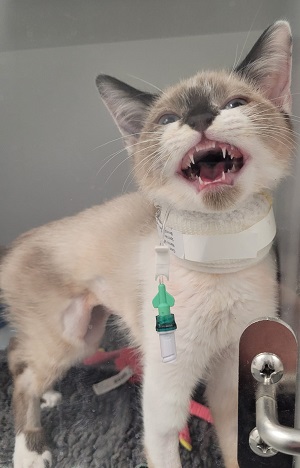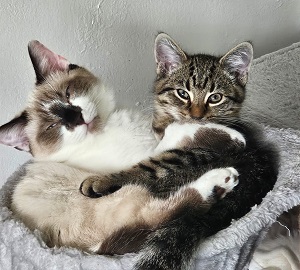Kitten’s Liver Shunt Surgery Success
Clinical Connections – Summer 2025
Grace Thomas (Resident in Small Animal Surgery) and Lynda Rutherford (Senior Lecturer in Small Animal Surgery) discuss the case of a kitten who had never known health or vitality until he was treated at the RVC.
Milo was presented to the RVC’s Emergency and Critical Care Service due to acute onset, severe neurological signs in late December, when he was four months old. On presentation, he was non-ambulatory, stuporous and in lateral recumbency.
Milo weighed 1.49 kg, with a body condition score of 4/9 and a muscle condition score of 2/3. He underwent initial emergency stabilisation in the ICU. Due to his young age and severity of neurological signs, it was suspected that Milo was suffering from hepatic encephalopathy secondary to portosystemic shunt.
Once stabilised, he was transferred to the Internal Medicine Service for further investigation and management. Milo underwent blood work to include bile acid stimulation and ammonia testing, urinalysis and abdominal CT. This confirmed an extrahepatic portosystemic shunt (gastric-caval).
Milo required an initial period of medical management at home to further stabilise his condition prior to surgery. As such he was discharged with lactulose oral solution and his owner was advised to exclusively feed him a low protein feline hypoallergenic diet.

Admission for surgery
Milo returned around a month later, under the care of the Soft Tissue Surgery Service. He had remained stable with medical management and as such was considered a candidate for surgery.
The risks of portosystemic shunt surgery were discussed to include general anaesthesia, bleeding, failure to fully attenuate his shunt and – most importantly – post-attenuation neurological syndrome (PANS). As Milo presented with neurological signs initially, the risk of him developing PANS was much higher.
Despite these risks, surgery was recommended due to an expected improved prognosis compared to long term medical management. As such, Milo’s owner wished to proceed with surgery.
Milo underwent general anaesthesia for attenuation of the extrahepatic portosystemic shunt and castration. Milo would not tolerate full attenuation of the shunting vessel, documented by increased portal pressure. As such, a cellophane band was placed around the shunting vessel to achieve partial attenuation, which was well tolerated.
The intention of this surgery is to allow scar tissue to slowly form around the attenuation, resulting in gradual closure of the shunt, increasing blood flow to the liver and encouraging normal development of the liver.
Recovery
Milo successfully recovered from the surgery and was hospitalised for five days postoperatively to monitor him closely for any signs of PANS. Somewhat unexpectantly, he recovered extremely well, with no signs of concern. He was eating, bright, comfortable and neurologically normal, so was discharged to continue medical management, a low protein diet and strict rest while he continued to recover from surgery.
Milo attended his local practice a fortnight after surgery for evaluation of his surgical wound. He then returned to the RVC to be re-examined by the Soft Tissue Surgery team in mid-April for routine reassessment. Milo had continued his excellent recovery with no signs of concern.

He underwent a repeat bile-acid stimulation test to evaluate his liver function. This had been markedly abnormal preoperatively and if persistently abnormal, Milo may have needed to undergo repeat surgery to further attenuate the shunting vessel. Pleasingly, his postoperative result was completely normal. With this result, combined with Milo’s perfect recovery, we were content that Milo’s liver function had recovered.
This condition can affect every patient differently, depending on the location and size of the shunting vessel. Milo was severely affected by his shunt, requiring emergency stabilisation for severe neurological signs. The severity of Milo’s condition preoperatively, increased the risks for him to undergo surgery, despite stabilisation.
Although, long term medical management was an option for Milo, this manages his clinical signs only as opposed to correcting the shunting vessel – and generally gives a poorer prognosis for patients, with a shorter life expectancy.
Due to the severity of Milo’s neurological signs, the risk of developing PANS, which can lead to blindness, seizures and death, was high. Milo’s owners had been fully prepared that there was a high chance that Milo could develop this postoperatively. Therefore, for Milo to beat the odds and sail through the surgery and recovery with no cause for concern was absolutely fantastic – and he will now live life as a happy, healthy cat.
Update from owner
“When I first got Milo, he wasn’t very playful, which I initially put down to his personality. But he had little appetite, dribbled after eating, was very clingy, and lethargic. He also had sneezing fits, small spasms, and occasional accidents. Our local vet couldn’t find anything obviously wrong, though Milo remained underweight and wasn’t growing. One night, he began losing control of his back legs and walking into walls. We rushed him to the vet, and he was referred to the RVC, where tests confirmed he had a liver shunt.
“After surgery and a special diet, the change in Milo was immediate. His coat became softer, he grew more independent, started eating well, and became energetic. His weight doubled, and follow-up blood tests were outstanding. He’s now off all meds, back on normal food, and living a happy, playful life with his buddy Gizmo.
“I can’t thank the RVC and the vets enough. They explained every step, treated Milo with such care, and supported me throughout. Grace, in particular, was amazing – her compassion and personal touch meant everything. Thanks to her and the whole team, Milo is not just surviving – he’s thriving!”
